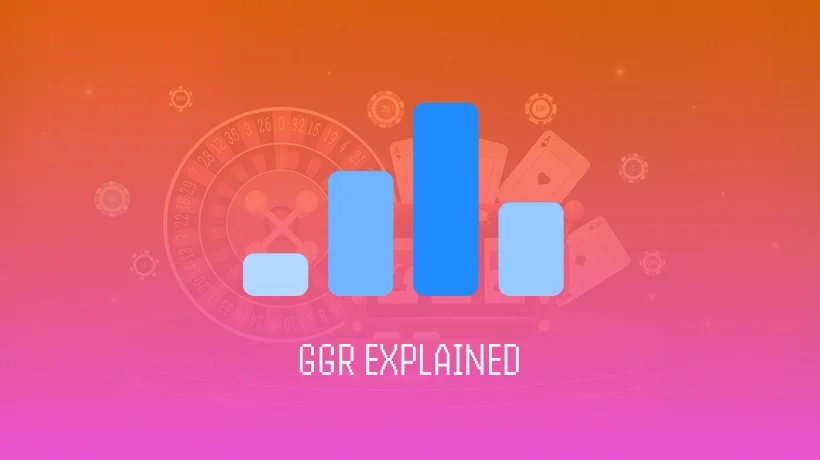Unlike metrics used for taxes or licensing, GGR reveals the true earning power of your platform. Operators rely on it to spot trends, refine strategies, and ensure their business model works.
Understanding how to calculate, report, and optimize GGR helps avoid costly mistakes — and turns raw data into insights that drive profit and growth.
What is GGR?
Gross Gaming Revenue (GGR) is a metric that represents the overall income your platform keeps after paying out player winnings.
To put it into perspective: If players wager €1 million and win €850 000, your GGR is €150 000.
Alternative terms to GGR that you’ll come across are the following:
- Gross game win
- Gross gaming yield
- Gaming win
All these terms convey the same meaning, but different software providers and regulators choose the term to use, despite the calculation remaining the same across the board.
The purpose of GGR is to shed light on your iGaming platform’s raw revenue-generating performance, excluding marketing costs, operational expenses and bonuses.
This is where the key value of GGR lies, allowing operators to conduct quick performance checks and receive immediate feedback on game performance that can determine if payout rates need adjusting before they negatively impact revenue.
GGR can impact your business in the following ways:
- If you base your major business decisions on GGR data, licensing authorities will receive validation that can increase the chances of application approval.
- You can avoid facing penalties from revenue authorities if your tax calculations depend on accurate GGR reporting.
- Conduct valuable competitor analysis by using GGR to compare platforms. This is often the first metric examined in financial reports.
- Game providers you partner with will track GGR to optimise their offerings with your platform. Trending games with solid GGR performance will take the priority spot for new features and updates.
Breaking Down The GGR Formula
It’s a good rule of thumb to have a mental note of the GGR calculation before you begin GGR tracking. To begin, learn the basic equation of the calculation:
GGR = Total Amount Wagered − Total Winning Payouts
Next, understand what each component of the equation means for daily operations:
- Total Amount Wagered: This represents the total amount wagered on your platform, encompassing slots, table games, live casino, and sports betting during your specified time period.
- Total Winning Payouts: This includes all money returned to players for winning outcomes and excludes promotional credits or bonuses.
Here is an example of the equation applied to a real-life scenario:
- Players wager: €5 000 000
- Winning payouts: €4 600 000
GGR = €5 000 000 − €4 600 000 = €400 000
Your platform generated €400 000 in gross gaming revenue from €5 million in player activity.
That’s an 8 % margin, which falls within the healthy range for most iGaming operations.
When it comes to reporting periods, GGR is commonly calculated by most operators using these timeframes:
- Daily: Essential for spotting immediate trends and issues
- Weekly: Good for operational reviews and staff meetings
- Monthly: Standard for regulatory reporting and tax filings
- Quarterly: Required for investor reports and license renewals
When selecting a reporting period, ensure it aligns with your regulatory requirements. For some jurisdictions, they demand daily GGR reporting, meanwhile others approve monthly submissions.
The most important aspect of reporting periods is consistency. Once established with reporting periods, continue to track them for accurate trend analysis.
How to Measure Efficiency with GGR Margin
GGR margin is the percentage of total wagers that remain with your business after payouts, telling you how efficiently your platform converts player activity into revenue. Picture it as your conversion rate from bets to actual income.
To break down the GGR Margin Formula, here is the equation and a real use-case example:
GGR Margin = GGR ÷ Total Amount Wagered
This calculation shows what percentage of player wagers becomes your gross revenue.
Here is a step-by-step calculation using the previous example:
- Total wagers: €5 000 000
- GGR: €400 000
- GGR Margin = €400 000 ÷ €5 000 000 = 8 %
Your platform kept 8 % of all money wagered. The remaining 92 % went back to players as winnings.
The industry benchmarks for healthy GGR vary:
- 8–12 % for slot games
- 10–15 % for table games
- 6–10 % for sports betting
The benchmark ranges can differ based on game type and market. Emerging markets commonly witness higher margins as players become accustomed to optimal strategies.
Margins that are too high can drive players towards competitors, but consistently low margins could signal overly generous payout rates. Therefore, it’s essential to strike the right balance. Common red flags you should watch out for include the following:
- Sudden margin drops (possible bonus abuse)
- Margins above 20 % (may indicate player retention issues)
- Volatile week-to-week changes (suggests unstable operations)
Track your margin trends monthly to spot performance issues before they affect profitability.
A Comparison Between GGR and NGR
To take GGR analysis one step further, you need to take into account Net Gaming Revenue (NGR), as it tracks the costs associated with running a gambling operation.
Unlike GGR, which shows raw revenue from gameplay, NGR reveals what’s left over after expenses. NGR deducts the following key business costs from your GGR figure:
- Bonus offers and promotional credits
- Affiliate marketing payouts
- Payment processing fees
- Licensing costs and regulatory fees
- Platform maintenance and support
Here is the NGR Formula represented in the following basic equation:
NGR = GGR − Operating Expenses
| Area | GGR | NGR |
|---|---|---|
| Definition | Revenue from player activity before costs | Actual earnings after business deductions |
| Formula | Bets − Payouts | GGR − Expenses |
| Revenue Stage | Early-stage revenue collection | Final-stage profit calculation |
| Business Use | Tracks volume and player activity | Assesses true profitability |
| Regulatory Role | License applications and reporting | Profit allocation and internal analysis |
| Bonuses & Fees | Not included | Fully included |
| Tax Considerations | Calculated before tax deductions | Taxes counted after GGR |
To fully maximise the potential of NGR, you need to check the NGR-to-Deposit ratio, which reveals what percentage of your players’ deposits converts into real revenue after total costs.
A healthy ratio range is between 50–65 %; anything below 40 % can lead to the following problems:
- Excessive bonus abuse
- High operational costs
- Poor player retention
- Inefficient marketing spend
Aim to track this ratio monthly alongside the GGR figure to provide an overall insight into your platform’s financial well-being.
Both GGR and NGR work together: GGR reveals your revenue potential, whereas NGR shows your actual profit-generating ability.
Methods to Boost Your GGR
GGR shouldn’t be used only for tracking; operators should actively try to boost GGR to increase the chances of success. Some optimal methods to boost GGR include:
- Game Variety Expansion: Player preferences differ significantly in iGaming, so make sure to offer a variety of slots, table games and live casino options. The more game types, the greater the opportunities for player engagement.
- Exclusive Content Investment: Offering branded or exclusive games that can’t be found on competitor platforms will create a unique selling point and improve player retention rates as players stick around for content they can’t find elsewhere.
- Mobile Performance Optimisation: With most players accessing gambling platforms via mobile devices today, fast load times and smooth mobile gameplay are essential.
- UI/UX Design Improvements: Game discovery should be made easy, with navigation that is intuitive, so players can find their favourite games just seconds after logging in. Fail to get this right, there are many competitors to turn to that can.
- Strategic Promotion Launches: Combine new game titles with relevant bonus offers such as free spins. Targeted promotions increase trial rates for new content.
- Regional Preferences Analysis: Tailor your game selection and promotional strategy to local tastes since different markets prefer different game types and themes.
- Proper Licensing Maintenance: Players trust regulated operators over unlicensed alternatives. Therefore, ensure that you display your licensing information prominently.
- Strong Security Implementation: Players bet more and stay on your platform when SSL encryption and secure payment processing are available to them to build player confidence.
Build Better Revenue Tracking with GGR
GGR forms the backbone of successful iGaming operations. Master this metric and you’ll make wiser business decisions across all departments.
Begin by implementing consistent GGR tracking across all your gaming verticals. Daily monitoring allows you to spot trends before they impact your bottom line.
The operators who succeed in the long term are those who turn GGR insights into actionable growth strategies.
Conclusion
Gross Gaming Revenue (GGR) is not just a financial figure — it is one of the key indicators of success in the online gambling industry. A clear understanding and proper use of GGR enable operators to make informed decisions, build effective growth strategies, and remain competitive in the fast-paced iGaming market.
Consistent GGR tracking helps identify product weaknesses, adjust payout rates, launch relevant promotions, and analyze player behaviour. When combined with other metrics such as NGR and GGR Margin, it provides a comprehensive view of a platform’s actual financial health.
Companies that treat GGR not merely as a reporting number, but as a tool for optimizing their business model, are the ones that lead the market. Start applying this knowledge in practice — and turn your data into actions that increase profitability and strengthen the long-term sustainability of your project.




